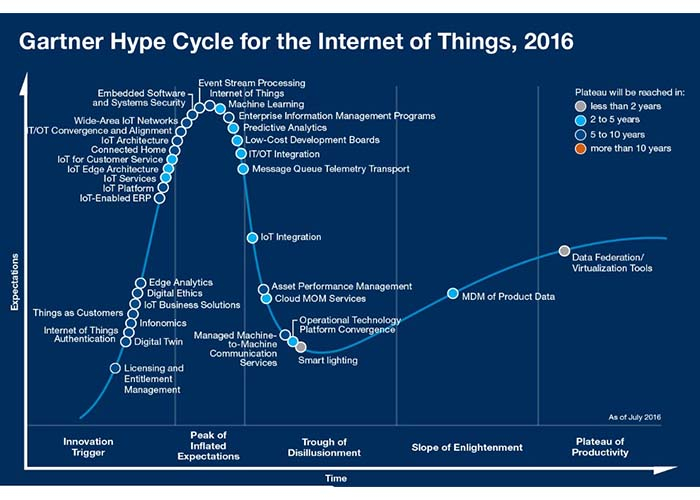IIoT Adoption – Are We There Yet?

IIoT Adoption – Are We There Yet?
Gartner’s hype cycle is an interesting way to look at technology adoption. From the humble beginning through the highs and lows to the eventual plateau, the cycle purports to cover the life of a tech phenomenon.
Gartner’s 2016 hype cycle for Internet of Things technology indicated IT/OT convergence and alignment were reaching the peak of inflated expectations (i.e., high hype but no tangible outcomes), and IT/OT integration was falling into the trough of disillusionment (i.e., the hype wasn’t proving out). But they also predicted these technologies would reach the plateau of productivity within 2-5 years, which begs the question – are we there yet?
Survey says
Survey results from 2017-18 suggest that manufacturers of industrial products lead the way at 44% IIoT adoption, as they move to create smart products with smart processes. Other core industries like automotive and oil & gas lagged significantly with adoption rates in the mid-teens or lower. And an Accenture survey cited lack of capital and poor infrastructure and communications as barriers to adoption, even though any 44-46% of respondents said they expect the IIoT to cut costs, increase productivity, and improve asset optimization.
Digitizing the factory is a start, but the key to unlocking it is the collection and analysis of the rich process data from your operations, as shown from these examples:
- A medical device manufacturer decreased maintenance costs by 20% thanks to insights from industrial analytics
- A petroleum company monitored equipment remotely – and saved millions in downtime and lost production
- A component manufacturer and service provider decreased failures and downtime by tracking cold storage assets at 4,500 supermarkets
Where does that leave you?
A broad definition of the IIoT might include any use cases where you’re connecting to devices and communicating their data to higher-level systems, even if these systems are not cloud-based or AI-enabled. Under this assumption it’s likely you are already using IIoT technologies like WiFi, wireless and cellular communications, and remote connectivity to manage machines within your operations.
If so, congratulations – you’re an IIoT adopter. Now the question is whether you can leverage that machine data to realize productivity gains. This starts with making sure you have the infrastructure in place to connect to machines, collect and translate the data, and communicate that data to a place where you can do the analysis to see what it’s telling you.
Practical advice to get started
Look for pragmatic applications – where are the critical machines in your process? Are you able to capture their data in a usable format and communicate it to a higher-level system? Start by connecting these machines to a larger network.
Don’t use IT gear to do an OT job – you need gear that was designed for rugged industrial environments, not air-conditioned data centers. Look to manufacturers who understand and can meet your operating requirements.
Don’t fret if you don’t have a fancy cloud app or AI – the first step to realizing benefits is to connect your devices and communicate the data in a common format to allow aggregation and analysis. As a start, some manual analysis based on your experience vs. an algorithm can turn that data into actionable information to drive improvement.
For more information on how to profit from IIoT, read our white paper.

